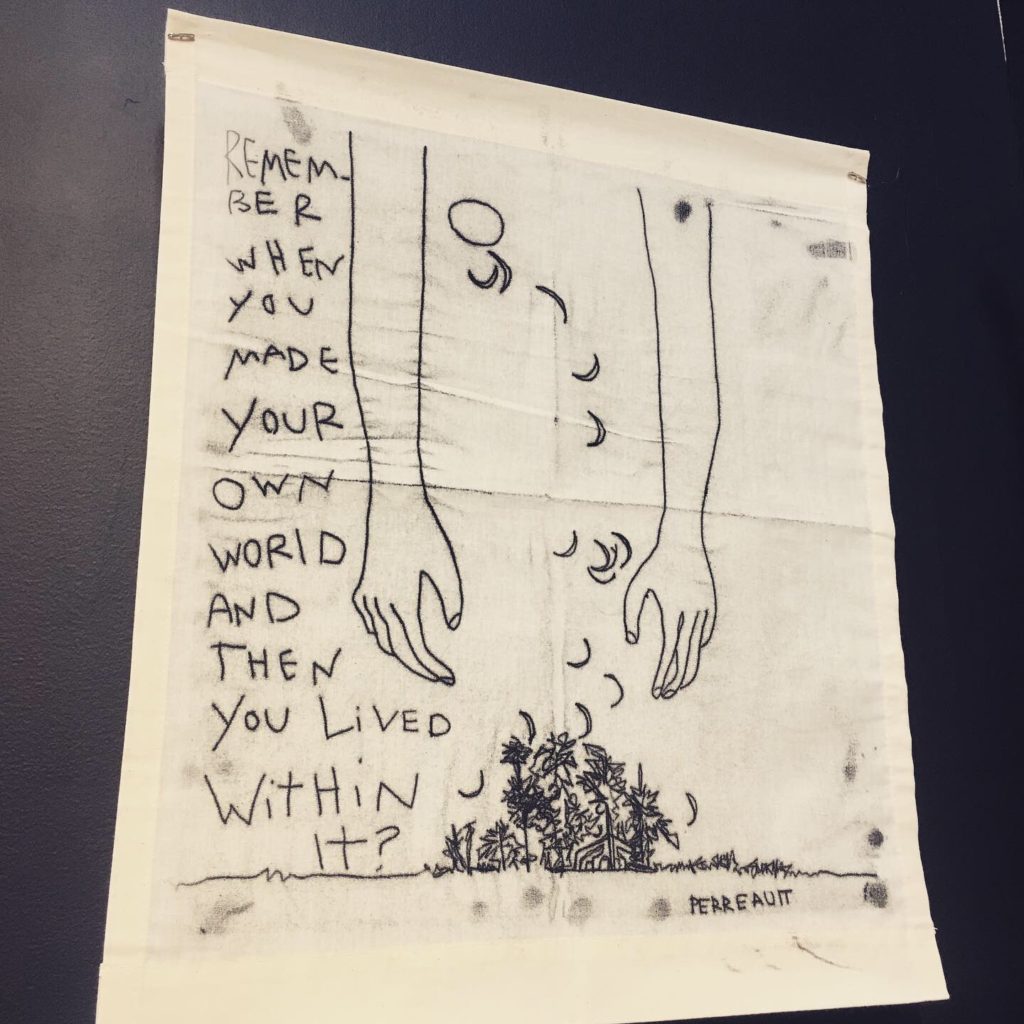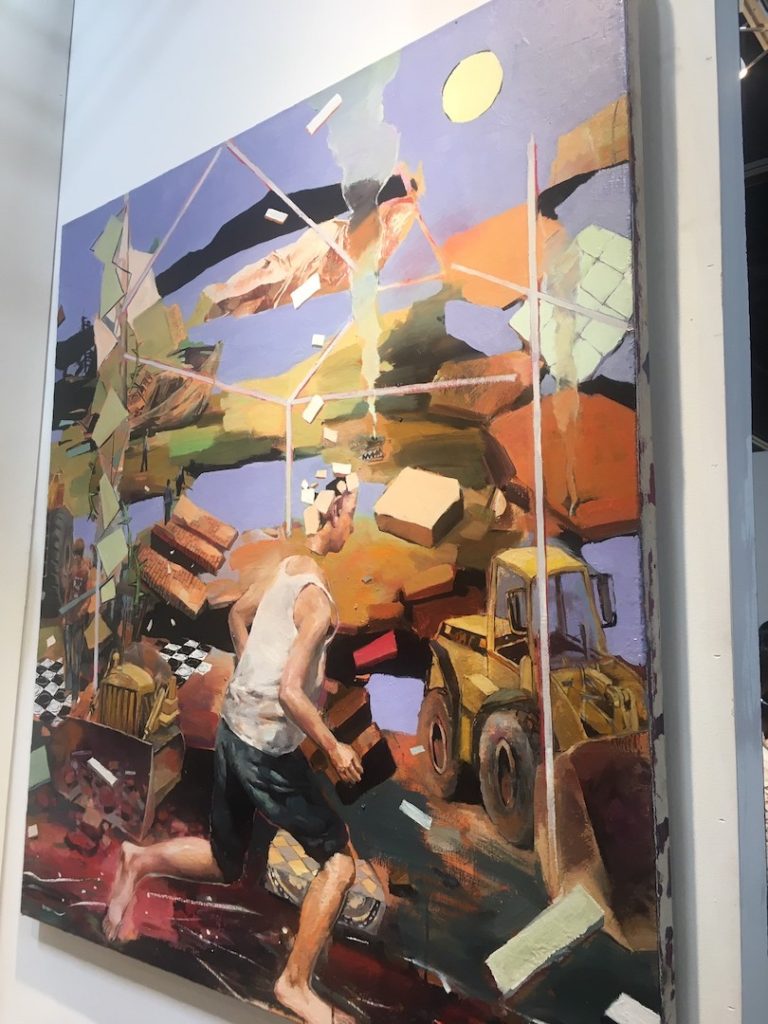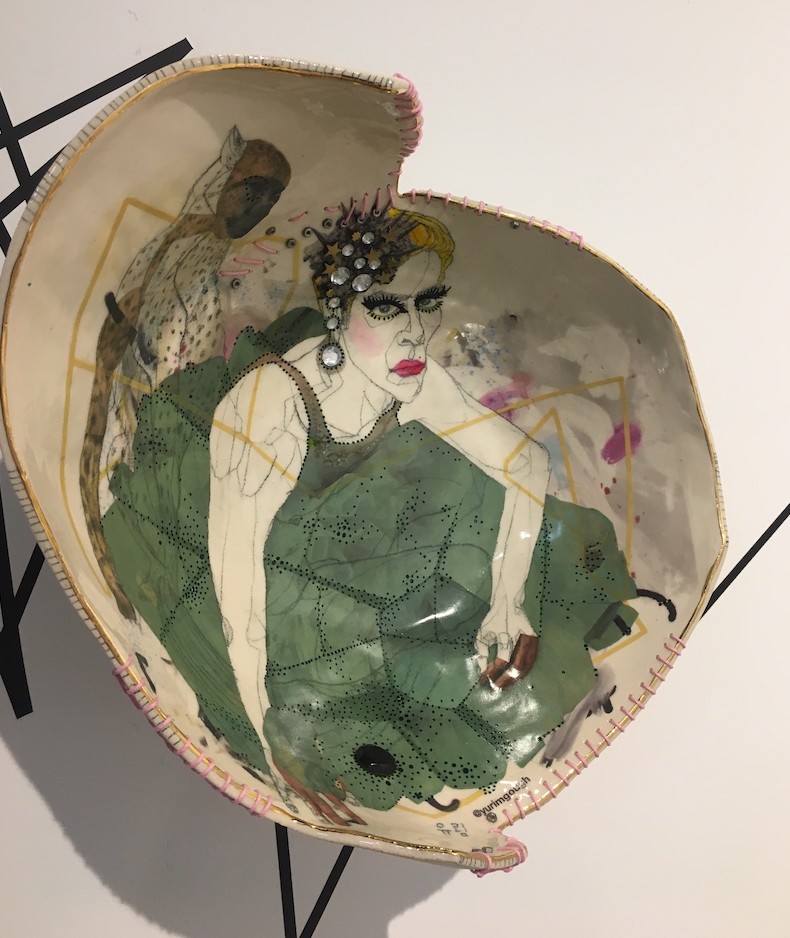
“Toss your baton in the air and run through the hallway of this world with both arms fully extended.” These words are scrawled across fabric on Valerie Perreault’s monotype prints, all of which are primarily word based (with some line drawing) and all of which are democratically declarative. Rooted in her poetry practice, these large pieces (3’x6’ banners) translate from the page fluidly and in their materiality they softly instruct, soothe and motivate. “Remember when you made your own world and then you lived within it?” she asks us. “Make a list of things you’ve yet to surrender,” “you are the rider and the horse,” she informs us. I stood up straighter when I read those words. And in a more traditional poetic form she tells us what she sees, “The world burning for love, the world burning for a little song la la, the world burning for a selfie, the world burning for a name lodged in a throat, the world burning for wing room in this aviary.”
Perreault’s was only one of many works within The Other Art fair that were at once heartbreaking and hopeful. Alexander Korzer-Robinson’s and Robert Robinson’s painstakingly precise cut book sculptures beautifully excavate history, reorder nature, elevate what may have been a secondary or invisible character and eliminate to present a new epic story. Robert Robinson’s reordering of the marvel comic books are meticulously executed and, of course, crowd pleasers. The marvel series continues to be resonant within our culture right now and the writing surrounding it is interestingly breaking form with archetypes to present hero’s with flaws, striking conversations on the complexities of being a human being with our spectrum of displays from genius to mental illness. The pieces also reminded me of the Philip Pullman quote, “After nourishment, shelter and companionship, stories are the thing we need most in the world.”

Elisa Valenti’s body-positive paintings carry an unapologetic vulnerability that translates into power in the paint. The command of her skills is clear while her statements on this movement carry strength. In her artist statement she explains “I grew up in a time when eating in public was shameful, stomach rolls made you unworthy, and shopping for clothes was traumatic. I grew up before being plus size was normal. My work reflects the images I wish I had seen—beautiful, luscious women doing ordinary things, just like everybody else. They are a reflection of my own battle with body image and my journey to mental health.” The worked reminded me of Lennon Flowers and the Reverend Jennifer Bailey, millennial leaders who founded the “People’s Suppers”, that bring together people across political chasms to share a meal and have a conversation. They have introduced an invitation to something different from “safe space” which they call “brave space.” Valenti is executing a brave space in her work and she ends her artist statement with a message for you to do the same, “If you’ve ever been made to feel insignificant, I hope they inspire you to own your image of yourself and never give that power to someone else.”

The paintings of Furong Zhang contain destruction and resurrection within not just the same image, but the same moment. They read like an animation still and make you feel like you have an understanding that what is falling apart in one place is being put back together in another so just stand still for one more moment and everything will be fine. They hold a tension in that way but also a trust. You begin to trust that the world is capable of repairing itself, that we are capable of repairing this world. The characters are the anchor to the work and, like in a dream, if you can see their eyes they are reassuring but if their face is turned away from you, the back of their head reveals it has turned to stone and falling apart. You feel a total sense of unease, even though you want to trust, and only relief when you wake up. Interestingly, Zhang was raised in Shanghai during the Cultural Revolution, and his paintings reflect his state, a state shared by many, of being between multiple cultures. In his work all structures are unstable; political, social religion. And everything is braided with his interior landscape, thoughts and memories. They remind me of another word that recently immerged with these movements of self care coined by author Robin Sharma “soulset,” which means, are you doing the conscious work of tending to your soul? And as I walked away from them I remembered the quote by poet Derek Wolcott, ”Break a vase, and the love that reassembles the fragments is stronger than that love which took its symmetry for granted when it was whole.”

Yurim Gough’s ceramic stoneware bowls are a show standout. The drawings have a bit of a Egon Schiele style to them and you don’t really need to learn (which you do) she only works from live models because you can feel it. The combination of the delicate lines with the many layers of bisque firing, glazing, firing again sometimes up to five times for a piece, create a palpable fragile/strong paradox. They then are installed with lines connecting them on the wall so although each piece is separate the presentation ties them together as constellations. Gough comes from Korea, a country with a historic tradition of ceramics and when living there she was a fashion designer, something that can be picked up as well in her style and aesthetic. She explains in her artist statement, “In Asian culture bowls are philosophically connected with humanity; for example in Korea we might talk about how big a bowl you have in your mind, so the bowl is holding all your knowledge and experience.” From the philosophical reference to the creation to the actual function of a bowl as an object itself, these pieces also point to several layers of nourishment. This work, like many in the show, also point to how fields such as fine art, craft and fashion that used to be very rigidly defined and contained, have no delineation between them whatsoever anymore and like the areas in the landscape where a river meets the land or a forest meets a field, all kinds of interesting things happen on that definition defying line between, that liminal place to create.

A final highlight, artist Sean Qualls aptly swims between painting, illustration and writing. His artist statement explains: “Growing up in the 70’s in central New Jersey, his family didn’t have much money for art supplies but he made the best of what was available; discarded paper, blank end pages from old books and sometimes walls much to his mother’s chagrin. Some of his earliest inspirations were the crayons and coloring books his mom would buy for him and his older sister, drawing and handwriting competitions with classmates and an illustrated bible he received for Christmas in the 2nd grade.” All of his work explores race & identity and the intersection of history & mythology and he has an extensive list of published books that he has written and illustrated that focus on unique and universal moments that reveal the human spirit. His work comes across as light, is even presented lightly, with humor and a light touch but that is the strength of it because it is not talking about light things. Similar to the writing of Mark Twain, who presented Huck Finn as a wild adventure story, the themes in the actual story were not the amazing American adventure but the reality of a seriously bigoted America. His work reminds me of the words of Angel Kyodo Williams who recently wrote, “We cannot have a healed society, we cannot have change, we cannot have justice, if we do not reclaim and repair the human spirit… to come into deep knowing of who we are — that’s the stuff that bringing down systems of oppression is made of. And so capitalism in its current form couldn’t survive. Patriarchy couldn’t survive. White supremacy couldn’t survive if enough of us set about the work of reclaiming the human spirit, which includes reclaiming the sense of humanity of the people that are the current vehicles for those very forms of oppression.” Through powerful imagery, phrases and stories, all the fluid forms that Qualls’ work roves between, he is planting seeds everywhere in asking you to do that work to come into a deep knowing and to really see who we are and how little these systems are serving our humanity. He, like many artists, are putting the work in to build a new mythology.
These works are a few examples of what led me to feel this overall tone of The Other Art Fair, one that I could only explain as simultaneously heartbreaking and hopeful. Valerie Perreault’s poetry reminds us of additional Derek Wolcott words, “For every poet it is always morning in the world; history a forgotten, insomniac night. The fate of poetry is to fall in love with the world in spite of history.” I felt a sense of constant recommitment to falling in love with the world from many artists working away in their unique languages, despite the moments when it feel like our world is falling apart. And I also felt they were not escaping whatsoever, but rather, holding “brave space.” Angel Kyodo Williams also comment on our times right now, saying “There is something dying in our society, in our culture, and there’s something dying in us individually. And what is dying, I think, is the willingness to be in denial. And that is extraordinary. It’s always been happening, and when it happens in enough of us, in a short enough period of time at the same time, then you have a tipping point, and the culture begins to shift. And then, where I feel like people are at now is, no, no, bring it on. I have to face it — we have to face it.” Many of these artists are saying that too, but they are also adding that they’ll walk you through.
____________________________________________________________________
Sarah Walko, is a contributor to Eyes Towards the Dove amongst many other wonderful things. The Other Art Fair was open at the Brooklyn Expo Center in Greenpoint, Brooklyn from November 7-10, 2019.
